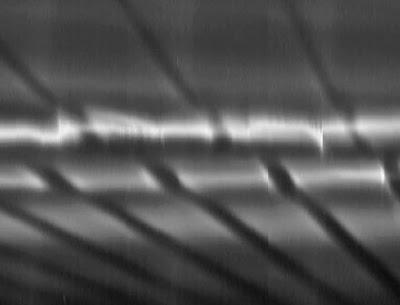
While orbiting Saturn for the last six years, NASA's Cassini spacecraft has kept a close eye on the collisions and disturbances in the gas giant's rings. They provide the only nearby natural laboratory for scientists to see the processes that must have occurred in our early solar system, as planets and moons coalesced out of disks of debris. New images from Cassini show icy particles in Saturn's F ring clumping into giant snowballs as the moon Prometheus makes multiple swings by the ring.
The gravitational pull of the moon sloshes ring material around, creating wake channels that trigger the formation of objects as large as 20 kilometers diameter. "Scientists have never seen objects actually form before," said Carl Murray, a Cassini imaging team member based at Queen Mary, University of London. "We now have direct evidence of that process and the rowdy dance between the moons and bits of space debris." Murray discussed the findings today the Committee on Space Research meeting in Bremen, Germany, and they are published online by the journal Astrophysical Journal Letters on July 14, 2010.
A new animation based on imaging data shows how one of the moons interacts with the F ring and creates dense, sticky areas of ring material. Saturn's thin, kinky F ring was discovered by NASA's Pioneer 11 spacecraft in 1979. Prometheus and Pandora, the small "shepherding" moons on either side of the F ring, were discovered a year later by NASA's Voyager 1. In the years since, the F ring has rarely looked the same twice, and scientists have been watching the impish behavior of the two shepherding moons for clues.
The gravitational pull of the moon sloshes ring material around, creating wake channels that trigger the formation of objects as large as 20 kilometers diameter. "Scientists have never seen objects actually form before," said Carl Murray, a Cassini imaging team member based at Queen Mary, University of London. "We now have direct evidence of that process and the rowdy dance between the moons and bits of space debris." Murray discussed the findings today the Committee on Space Research meeting in Bremen, Germany, and they are published online by the journal Astrophysical Journal Letters on July 14, 2010.
A new animation based on imaging data shows how one of the moons interacts with the F ring and creates dense, sticky areas of ring material. Saturn's thin, kinky F ring was discovered by NASA's Pioneer 11 spacecraft in 1979. Prometheus and Pandora, the small "shepherding" moons on either side of the F ring, were discovered a year later by NASA's Voyager 1. In the years since, the F ring has rarely looked the same twice, and scientists have been watching the impish behavior of the two shepherding moons for clues.
No comments:
Post a Comment